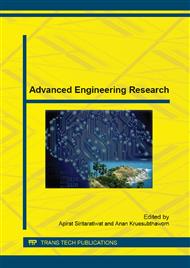p.337
p.341
p.346
p.351
p.357
p.361
p.366
p.370
p.374
Development of Smart Plug Using Power Line Communication
Abstract:
This paper describes the development of Smart Plug using power line communication. The smart plug system is comprised of two main components which are Smart Plug and Data Concentrator. Smart Plug is a wall outlet which is able to measure power consumption and to control (turn on/off) the connected load via UDP protocol. Smart plug will measure the voltage, current, energy and power consumption of electric home appliances that are connected to it and broadcast these data over the distributed power wires. Data Concentrator is a center of data accessing between the user and each of the smart plug in the system. System owners can access the system to get the electricity consumption data in their system or to control the operation of electric home appliances that are connected to any smart plug by a personal computer or a smart device. Each smart plug has 16-bit unique ID for address identification in the system so this system can support up to 65,536 smart plugs.
Info:
Periodical:
Pages:
357-360
Citation:
Online since:
August 2015
Authors:
Price:
Сopyright:
© 2015 Trans Tech Publications Ltd. All Rights Reserved
Share:
Citation:


